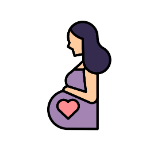
Physiotherapy
How Can Physiotherapy Helps My Prenatal And Postnatal Journey?
10 min | Updated on 30-03-2023 by HappyPreggie
Physiotherapy done during pregnancy helps the body deal with issues related to mobility, musculature, circulation and respiration. Prenatal physiotherapy can ease lower back pain, reduce incontinence, and make your labour and delivery easier, while postnatal physiotherapy helps regain muscle strength in the back, pelvic area and abdominal muscles to help the new mother strengthen the core and impart energy. Before registering for an antenatal or postnatal program, you will have to undergo a thorough evaluation to determine which exercises would be the most suitable for you.
Ms Koon Yi Jing, a Physiotherapist with B.Sc. (Hons.) Physio. (H.K.), Dip. Acupuncture (H.K.), M. Sc. Sports and Ex. Med. (U.K.) and DMA Pilates (Aust.) certifications will give detailed explanations on the topic of prenatal and postnatal physiotherapy to help you understand the process better.
Q1. What can I expect in a physiotherapy appointment and what kind of assessments are involved?
(Image credits to ProPhysiotherapy)
In your first session, an initial assessment will be performed to understand your problems and the underlying causes of your pain and dysfunctions. This will include checking your spinal and pelvic alignment and testing your movements/ mobility and strength.
Treatment will then be carried out which may include a combination of manual therapy, joint mobilisation, soft tissue release, dry needling, acupuncture and taping.
Lastly, rehabilitation exercises targeting your specific issues will be prescribed to be performed at home.
Q2. Is it safe to work out through my third trimester? How does maternal exercise benefit the foetus?
In the absence of contraindications (risks of miscarriage or preterm labour), most healthy pregnant women are safe and even should be encouraged to exercise. There are guidelines for choosing an exercise during pregnancy and ensuring exercise/ workout is carried out safely.
Benefits of maternal exercise for the foetus include
- Baby is less likely to be underweight
- Baby has more mature brain development
- Baby has a healthier heart
- An easier birth and less foetal distress during delivery
Q3. What are the common physical conditions during pre & postnatal and when is the right time to look for physiotherapy?
(Image credits to Sport and Spinal Physiotherapy)
Common pain and discomfort during pregnancy include
- Back pain, sciatica, numbness
- Pelvic girdle pain, pubic symphysis pain, tailbone pain
- Incontinence, constipation, prolapse
- Diastasis recti (belly separation)
- Mummy thumb
If you experience pain during pregnancy, you are advised to seek help as soon as possible as this will not only give you a comfortable pregnancy but also ensure a smoother natural delivery as most pain and discomfort signal some structural imbalances that might impact the opening of her pelvis during birth.
During postnatal, most pain and discomfort gradually reduce in the first 6 weeks. If you are still experiencing pain after 6 weeks, a visit to a women's health physio is beneficial.
Q4. How do prenatal exercises differ from postnatal? Can you provide some examples and benefits of the activities involved?
(Image credits to Anatomy Physiotherapy)
Pre and postnatal exercises can be quite similar except for some positioning during pregnancy. We would try to avoid performing exercises lying on the back especially in the 3rd trimester, as this might affect the blood flow.
Core exercises, breathing exercises as well as pelvic floor training are among the most important exercises for both pre and postnatal. Mastering these exercises does not only prevent different kinds of pain and ache during pregnancy but also encourages an easier birth and a faster recovery postpartum.
Q5. Many women experience pelvic and lower back pain during their pregnancy. Is there anything I should be concerned about and how can a physiotherapist help me with the pain?
The growing of the belly often leads pregnant women to change the way they sit, stand, walk and sleep. This is often one of the major causes of pelvic and lower back pain. In addition, when the strength of the muscles around the pelvis could not catch up with the increase in the weight of the baby/belly, it can also increase the stress around the lower back and the pelvis.
A physiotherapist will guide you on how to move optimally and efficiently with your growing belly by advising on a more ideal alignment for sitting, standing and sleeping. In addition, manual therapy for pelvic adjustment helps women struggling with pain to recover faster.
Q6. How long after I have my baby can I start postnatal physiotherapy? How does the session differ between vaginal and caesarean delivery?
(Image credits to Intermountain Healthcare)
We recommend having a postnatal physio checkup around 6-8 weeks postpartum.
Scar tissue forms around the wound during both vaginal and caesarean birth. Scar tissue over the perineum (for vaginal birth) and lower belly (for caesarean birth) will be assessed and mobilised if required. These scar tissues often contribute to postpartum back and pelvic pain.
Q7. How can I safely reduce my postpartum weights and belly through a physiotherapy session and how long does it take?
We guide postpartum women to exercise safely by first correcting the imbalanced structures before prescribing individualised rehabilitation exercises to address their specific needs. We also ensure the exercise is safe for the pelvic floor to prevent and treat incontinence, prolapse and the separation of the belly.
Most women notice significant changes within 3-4 sessions. A woman after having 3 kids (between 2-5 years old) with an unresolved belly and a protruded belly button was told that surgery is the only way to treat her belly hernia and diastasis recti (separation of belly). We had 6 sessions in 3 months and she not only had her belly button flatten, but the belly button sunk into its original state. Every woman however improves at their own pace.
Q8. How does Beyond Physio help pregnant women who opted for VBAC (vaginal birth after caesarean) and what are the risks involved?
We help women who are attempting VBAC with
- Mobilisation of previous caesarean scar to prevent uterine scar rupture when attempting VBAC (which is often the most concerning issue and why most Drs suggest sticking with a caesarean for subsequent births)
- Getting baby into the best head down + LOA (left occiput anterior) position to facilitate a natural birth
- Make sure the pelvic floor can relax to allow the baby to exit
- The correct breathing and pushing techniques
Having a gynaecologist who is experienced and supportive of VBAC is extremely important. The risks involved shall be discussed with the respective gynaecologist.
Q9. What are the qualifications that I need to look for in a pre and postnatal physiotherapist?
(Image credits to iStock)
Look for a physiotherapist who can perform pelvic floor assessment and treatment (both internal and external techniques) as this is a common issue in pre and postpartum women. It is often a missing puzzle when treating pre and postnatal women without looking at the pelvic floor.
Institute of Birth Healing is a prestigious organisation in the US that provides continuous education to train women's health physiotherapists specifically in the pre and postnatal field. To our best knowledge, we are currently the only Malaysian physiotherapist trained by the institute.
We hope that this Q&A Series With Expert will resolve the common questions you have about prenatal and postnatal physiotherapy. With the right support and treatment, you will be able to experience better prenatal and postnatal experiences. Read more on our physiotherapy related-topic articles here: Postpartum Care Essentials For Recovery and 6 Casual Exercises For Pregnant Mothers To Stay Fit.
Join the largest support network for family health and well-being. Ready to get started?
Get started
















